

With our practical LM digital adapters, the Leica MZ6 stereo microscope can be equipped for photography with modern DSLR and system cameras in no time.
The Leica MZ6 is a high-quality stereo microscope designed according to the telescope principle. As it is equipped with an infinity-corrected optical system, it is particularly suitable for digital photography using DSLR and system cameras. Typical areas of use include industrial, hospital and laboratory applications.
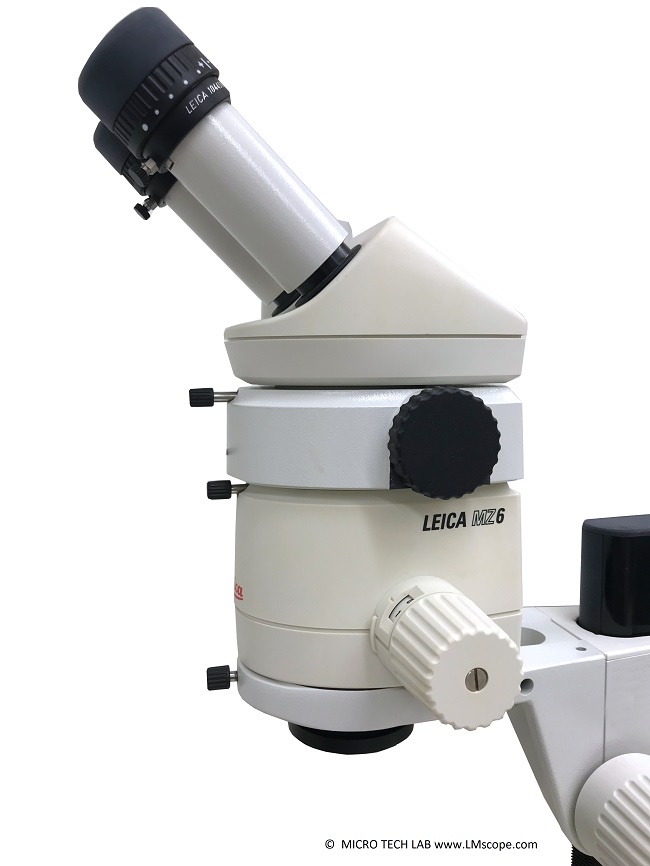
The MZ6 is a modern, high-performance stereo microscope with a modular design. Leica produced this model until 2010, when it was replaced by the M60. An extensive range of accessories is available for the MZ6, including the Leica MATS thermocontrol system (for live cell biology), cross stages and a large selection of stands and swing-arm systems.
Leica’s M-series microscopes have two parallel beam paths and one main objective.
Thanks to its ergonomic design, the Leica MZ6 is easily adjustable to accommodate different body heights. Other accessories are available for the ergonomic tubes as well, such as the ErgoWedge +/- 15º.
Where illumination is concerned, Leica also offers a variety of options: cold light source, LED, incident light fluorescence, coaxial incident light and ring light.
As with all stereo microscopes, the Leica MZ6’s two parallel beam paths make it less than ideal for photography. In its favour, however, the MZ6 has an excellent infinity-corrected optical system, which – combined with our LM digital adapters – enables it to deliver good photographic and video material at low magnification levels (<30x). For magnifications below 30x, full-frame DSLR cameras are the best choice.
Thanks to Leica’s modular system and the extensive range of available accessories, cameras can be attached to the microscope in several different ways, depending on the photo tube:
1.) Beam splitter module with long arm
This beam splitter was developed for analogue SLR cameras. The image shows a customised solution for a Sony Alpha DSLR equipped with an APS-C sensor.
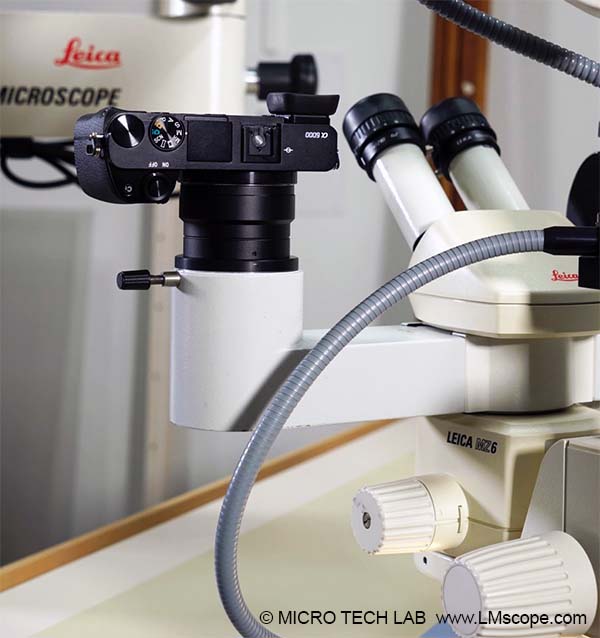
2) Beam splitter (HU) with adjustable iris diaphragm (38 mm internal diameter)
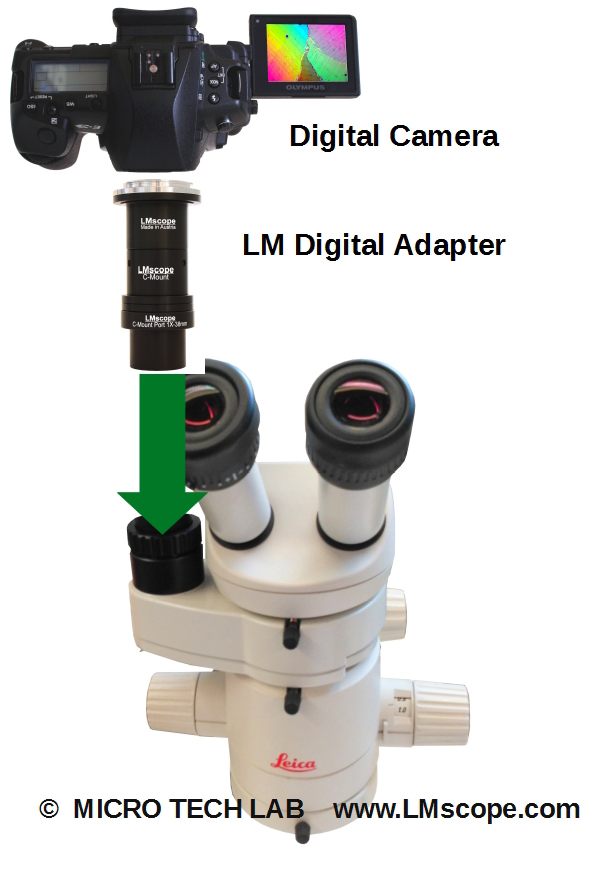
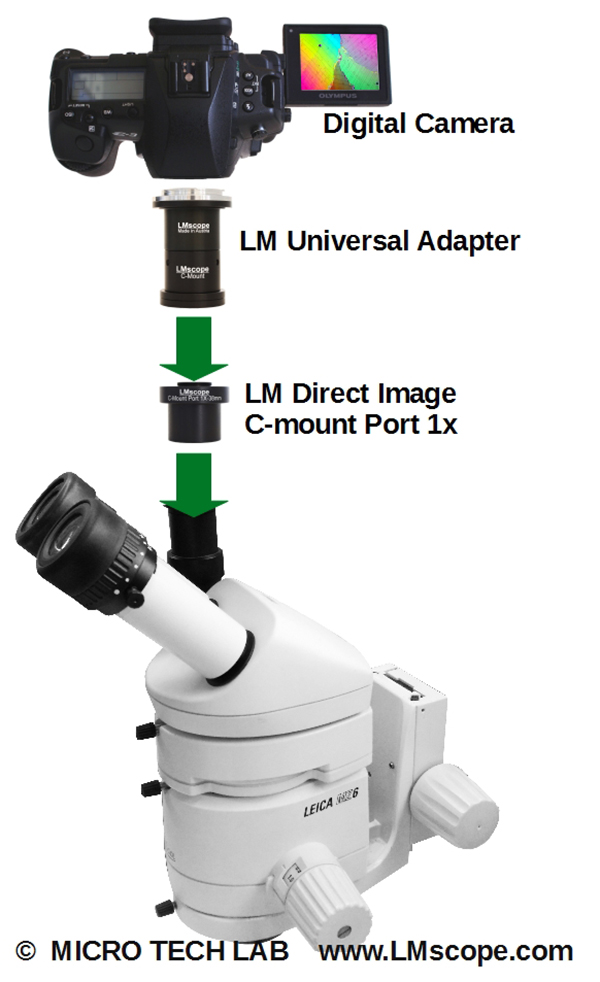
3) Trinocular head with vertical photo tube (36 mm external diameter)
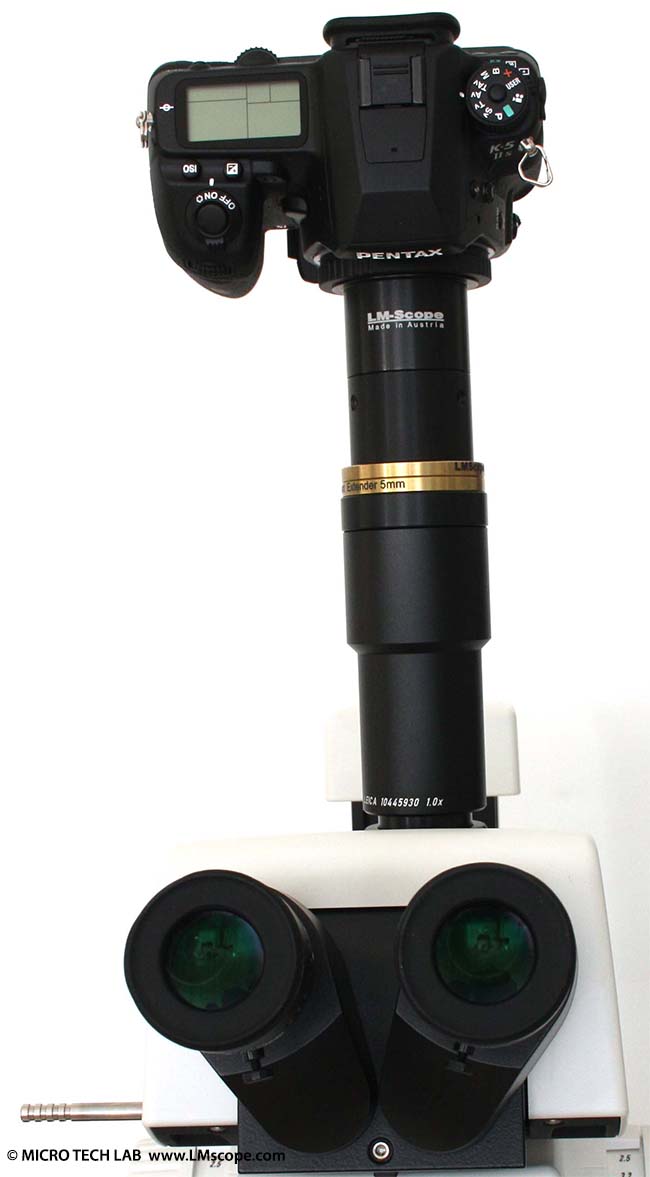
4) Adapter solution for eyepiece installation
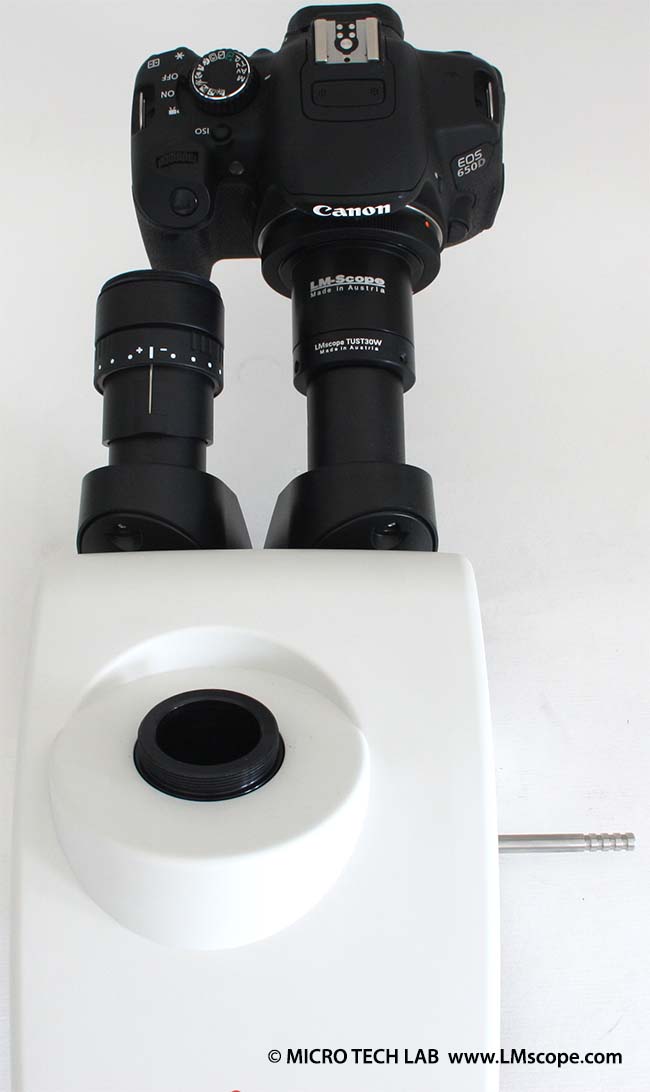
Microscopy methods: Transmitted light (bright field, dark field) incident light (bright field, fluorescence)
Microscope stand: stereomicroscope, no display
Optics: infinite, 2 parallel beam paths
Focal adjustment: manually or motorised
Manual diaphragm: yes
Stage: heatable
Original camera: compact cameras Leica IC A and IC D, MPS 30/ MPS 60 / SLR camerasystem
Illumination: Fluorescence-LED, LED, coaxial incident light
Optical zoom: yes (6.3:1) with clickstop
Magnification range: 2 to 300 (depending on eyepieces and objectives)
Objectives: planApo, plan, achromate, planachromate
Eyepieces: 30mm (10x/21, 16x/14, 25x/9,5, 40x/6)
Additional information: Stereo fluorescence-module (incident light)
Photography:
Fitting the microscope to digital single-lens reflex (DSLR), mirrorless interchangeable-lens cameras (MILC ), digital single-lens mirrorless (DSLM) or C-mount cameras is easy with our LM digital SLR adapters, which feature a plan achromatic optical system. Our products make it possible to capture top-quality microscope images. To help you select the adapter that is right for your camera, we have set up an online configurator on our website. You can also email us – ideally with attached photographs of your microscope.
Modern DSLR and single-lens mirrorless (DSLM) offer the latest technology and are generally very well suited for microscopy applications. Most of them can be controlled remotely via PC/Mac. Because of their high sales volumes, they offer an excellent price/performance ratio compared to special-purpose microscope cameras.
Features of top DSLR and single-lens mirrorless cameras (DSLM):
- Large, powerful full-frame sensors (36 x 24 mm)
- Sensor resolution of 61 megapixels or 240 megapixels with Pixel Shift technology
- High light sensitivity (ISO 400,000+)
- Extensive dynamic range (up to 15 aperture stops/f-stops)
- Short exposure times (1/8000 second) up to 1/32,000 seconds using the digital shutter
- 4K Ultra HD or 8K Ultra HD video function
- Live video capture on external monitors in ultra HD quality
In most cases, these cameras are significantly more powerful than microscope cameras with smaller sensors (1/2" or 2/3"). On our website you will find our current camera recommendations and a camera ranking which is specifically tailored to microscopy applications.
New LM Digital Adapter for: Nikon Z9 / Nikon Z8 / Sony Alpha 7R V / Sony Alpha 1 II / Sony Alpha 1 / Sony Alpha 9 II (ILCE-9M2) / Sony FX3 Cinema Line / Sony Alpha 9 / Nikon D6 / Canon EOS R3 / Canon EOS R6 Mark II / Canon EOS R8 / Sony Alpha 7R IV / Canon EOS R5 II / Nikon Z6III / Canon EOS R5 / Sony Alpha 7S II / Sony Alpha 7S III / Sony Alpha 7R III / Canon EOS R6 / Nikon Z6 / Nikon Z6II / Sony Alpha 7R II / Nikon Z7 / Nikon Z7II / Canon EOS R / Canon EOS Ra (Astro) / Nikon Z5 / Sony Alpha 7C / Canon EOS RP / Sony Alpha 7S / Canon EOS R7 / Leica SL2-S / Canon EOS R10 / Nikon Z50 II / Canon EOS 1D X Mark III / Nikon Z50 / Nikon Z30 / Nikon Z fc / Nikon D850 / Canon EOS 1D X Mark II / Nikon D780 / Olympus OM-1 / Sony Alpha 7III / Olympus OM-D E-M1 Mark III / Canon EOS R100 / Sony Alpha 6700 / Nikon D5 / Sony Alpha 6600 / Fujifilm X-H2S / Fujifilm X-S10 / Fujifilm X-E4 / Fujifilm X-Pro3 / Olympus OM-D E-M1X / Sony Alpha 6400 / Sony Alpha 6100 / Sony ZV-E10 / Canon EOS 1D X / Nikon D4s / Olympus OM-D E-M5 III / Canon EOS 90D / Canon EOS 5D Mark IV / Nikon D4 / Nikon D750 / Canon EOS 6D Mark II / Fujifilm X-T5 / Fujifilm X-T4 / Fujifilm X-T3 / Sony Alpha 6300 / Sony Alpha 6500 / Nikon D500 / Nikon D810 / Nikon D800 / Canon EOS M6 Mark II / Nikon D800E / Nikon Df / Panasonic Lumix DC-G9 / Nikon D610 / Nikon D600 / Canon EOS 250D / Canon EOS 850D / Rebel T8i / Canon EOS 6D / Sony Alpha 99 II (SLT-A99 II) / Canon EOS M200 / Canon EOS 5DS R ( without low-pass filter) / Olympus OM-D E-M1 Mark II / Canon EOS 80D / Canon EOS M50 Mark II / Canon EOS 5DS / Canon EOS M50 / Sony Alpha 77 II / Canon EOS 70D / Nikon D7200 / Pentax K-1 Mark II / Canon EOS 200D / Canon EOS 800D / Rebel T7i / Canon EOS 77D / Canon EOS 5D Mark III / Canon EOS 60D / Sony Alpha 7R /